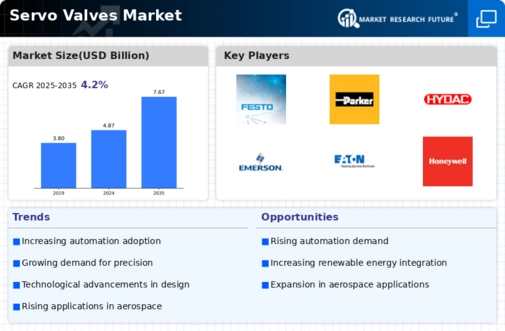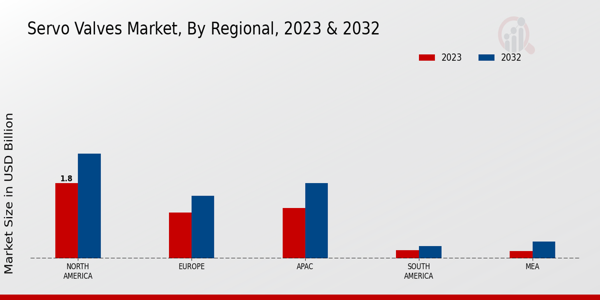Market Trends and Projections
The Global Servo Valves Market Industry is poised for substantial growth, with projections indicating a market value of 4.87 USD Billion in 2024 and an anticipated increase to 7.67 USD Billion by 2035. This growth trajectory suggests a compound annual growth rate (CAGR) of 4.21% from 2025 to 2035, driven by various factors including technological advancements, increasing automation, and rising energy efficiency demands. The market dynamics are influenced by the expanding applications of servo valves across diverse industries, indicating a robust and evolving landscape for manufacturers and stakeholders.
Increasing Automation in Industries
The Global Servo Valves Market Industry is experiencing a notable surge due to the increasing automation across various sectors. Industries such as manufacturing, aerospace, and automotive are increasingly adopting servo valves to enhance precision and control in their operations. This trend is driven by the need for improved efficiency and reduced operational costs. As automation technologies advance, the demand for servo valves is projected to grow, contributing to the market's expansion. In 2024, the market is valued at 4.87 USD Billion, indicating a robust growth trajectory as industries seek to optimize their processes.
Rising Demand for Energy Efficiency
Energy efficiency is becoming a critical focus for industries globally, propelling the Global Servo Valves Market Industry forward. Servo valves play a pivotal role in optimizing energy consumption by providing precise control over fluid dynamics in hydraulic and pneumatic systems. This efficiency not only reduces operational costs but also aligns with global sustainability goals. As industries strive to meet regulatory standards and consumer expectations for energy-efficient solutions, the demand for servo valves is likely to increase. The market is expected to reach 7.67 USD Billion by 2035, reflecting a growing emphasis on energy-efficient technologies.
Expansion of Renewable Energy Projects
The expansion of renewable energy projects globally is contributing to the growth of the Global Servo Valves Market Industry. Servo valves are essential in managing fluid control in various renewable energy applications, such as wind turbines and hydroelectric plants. As countries invest in sustainable energy solutions to combat climate change, the demand for efficient fluid control systems is expected to increase. This trend aligns with global efforts to transition towards greener energy sources, thereby enhancing the market's potential. The ongoing investments in renewable energy infrastructure are likely to create new opportunities for servo valve manufacturers.
Growth in Aerospace and Defense Sector
The aerospace and defense sector is a major driver of the Global Servo Valves Market Industry, as these industries require high-performance components for critical applications. Servo valves are integral to flight control systems, landing gear, and other hydraulic systems in aircraft. The increasing demand for advanced aerospace technologies and the modernization of defense systems are expected to boost the market significantly. With governments investing in defense capabilities and the aerospace industry expanding, the demand for reliable and efficient servo valves is likely to rise, further propelling market growth.
Technological Advancements in Servo Valve Design
Technological advancements are significantly influencing the Global Servo Valves Market Industry, as innovations in design and materials enhance performance and reliability. Modern servo valves are equipped with advanced features such as digital control systems and improved response times, which cater to the evolving needs of various applications. These advancements not only improve operational efficiency but also extend the lifespan of the equipment. As industries adopt these cutting-edge technologies, the market is anticipated to grow at a CAGR of 4.21% from 2025 to 2035, highlighting the importance of innovation in driving market dynamics.























